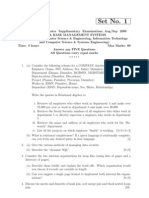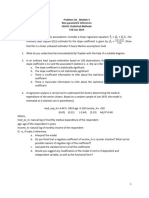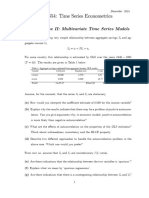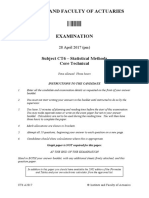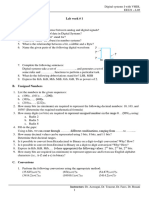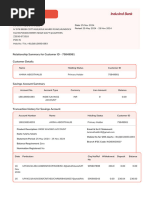Tutorial 3 Questions
Uploaded by
BellaTutorial 3 Questions
Uploaded by
BellaRMIT
Classifi
cation:
Basic Econometrics
Truste
Tutorial 3 Questions
d
Question 1)
The following model is a simplified version of the multiple regression model used by Biddle
and Hamermesh (1990) to study the tradeoff between time spent sleeping and working and
to look at other factors affecting
sleep=β 0 + β 1 totwrk + β 2 educ+ β 3 age+u ,
where sleep and totwrk (total work) are measured in minutes per week and educ and age
are measured in years. (See also Computer Exercise in Tutorial 2.)
(i) If adults trade off sleep for work, what is the sign of β 1?
(ii) What signs do you think β 2 and β 3 will have?
(iii)Using the data in SLEEP75, the estimated equation
sleep=3638.25−.148totwrk −11.13 educ +2.20 age
n=706 , R 2=.113 .
If someone works five more hours per week, by how many minutes is sleep predicted to
fall? Is this a large tradeoff?
(iv)Discuss the sign and magnitude of the estimated coefficient on educ.
(v)Would you say totwrk, educ, and age explain much of the variation in sleep? What other
factors might affect the time spent sleeping? Are these likely to be correlated with totwrk?
Question 2)
The following equation describes the median housing price in a community in terms of
amount of pollution (nox for nitrous oxide) and the average number of rooms in houses in
the community (rooms
l og ( price )=β 0−β 1 log ( nox ) + β 2 rooms+u
(i)What are the probable signs of b1 and b2? What is the interpretation of b1? Explain.
(ii)Why might nox [or more precisely, log(nox)] and rooms be negatively correlated? If this is
the case, does the simple regression of log(price) on log(nox) produce an upward or a
downward biased estimator of b1?
(iii)Using the data in HPRICE2, the following equations were
log ( price )=11.71−1.043 log ( nox ) , R2=. 264
RMIT
Classifi
cation:
Truste
d
l og( price)=9.23−0. 718 log(nox )+ 0.3 06 rooms , R2=.5 14
Is the relationship between the simple and multiple regression estimates of the elasticity of
price with respect to nox what you would have predicted, given your answer in part (ii)?
Does this mean that is −0. 718 definitely closer to the true elasticity than −1.043?
Question 3)
The following equation describes the median housing price in a community in terms of
amount of pollution (nox for nitrous oxide measured as parts per million) and the average
number of rooms in houses in the community (rooms).
Suppose, using data on house prices (measured in thousands of NZ dollars) from various
cities of New Zealand, the following equation was estimated:
l og( price)=6.15−0.824 log(nox)+0.376 rooms , n=303 , R2=.522 .
i. Interpret the estimates of 6.15 and -0.824.
ii. If the house owners living in a community in Auckland with two bedrooms per house
on average decide to renovate their houses so the average number of bedrooms in
the community becomes four, then given nox = 5.24, predict the pre- and post-
renovation median prices of the house. Interpret the change in the price.
COMPUTER EXERCISES FOR R
Question 4)
The file CEOSAL2 contains data on 177 chief executive officers and can be used to examine
the effects of firm performance on CEO salary.
(i)Estimate a model relating annual salary to firm sales and market value. Make the model of
the constant elasticity variety for both independent variables. Write the results out in
equation form.
(ii)Add profits to the model from part (i). Why can this variable not be included in
logarithmic form? Would you say that these firm performance variables explain most of the
variation in CEO salaries?
(iii)Add the variable ceoten to the model in part (ii). What is the estimated percentage
return for another year of CEO tenure, holding other factors fixed?
(iv)Find the sample correlation coefficient between the variables log(mktval) and profits.
Are these variables highly correlated? What does this say about the OLS estimators?
You might also like
- Econ 466 Fall 2010 Homework 5 Answer Key: β / (2 - ˆ β -), or .0003/ (.000000014) ≈ 21, 428.57; reNo ratings yetEcon 466 Fall 2010 Homework 5 Answer Key: β / (2 - ˆ β -), or .0003/ (.000000014) ≈ 21, 428.57; re4 pages
- Example 3.5 Design of A Simply Supported Concrete Beam (BS 8110)No ratings yetExample 3.5 Design of A Simply Supported Concrete Beam (BS 8110)8 pages
- Assignment 1: The Simple Linear Regression ModelNo ratings yetAssignment 1: The Simple Linear Regression Model3 pages
- SEM 4 - 10 - BA-BSc - HONS - ECONOMICS - CC-10 - INTRODUCTORYECONOMETRI C - 10957No ratings yetSEM 4 - 10 - BA-BSc - HONS - ECONOMICS - CC-10 - INTRODUCTORYECONOMETRI C - 109573 pages
- Econometrics For ECO 2022 Tutorial 03 PDFNo ratings yetEconometrics For ECO 2022 Tutorial 03 PDF2 pages
- Lecture 8+9 Multicollinearity and Heteroskedasticity Exercise 10.2No ratings yetLecture 8+9 Multicollinearity and Heteroskedasticity Exercise 10.23 pages
- CAO107 - Assessmennt 1 Workbook QuestionsNo ratings yetCAO107 - Assessmennt 1 Workbook Questions10 pages
- 5 MODULE 3_4ec82e15cff01b60966d1026ebefdf8cNo ratings yet5 MODULE 3_4ec82e15cff01b60966d1026ebefdf8c86 pages
- University Institute of Engg.: Bachelor of Engineering (Computer Science & Engineering) Digital Electronics 22ECH-101No ratings yetUniversity Institute of Engg.: Bachelor of Engineering (Computer Science & Engineering) Digital Electronics 22ECH-10114 pages
- Name: . ID No: .. BITS-Pilani Dubai Campus Econ F241 Econometric Methods Semester I, 2018test-1 (Closed Book)No ratings yetName: . ID No: .. BITS-Pilani Dubai Campus Econ F241 Econometric Methods Semester I, 2018test-1 (Closed Book)6 pages
- University of Mauritius: Faculty of Social Studies & HumanitiesNo ratings yetUniversity of Mauritius: Faculty of Social Studies & Humanities4 pages
- BBA-05 BBA - Ist Year Examination Fundamentals of Business Statistics Paper - BBA-05No ratings yetBBA-05 BBA - Ist Year Examination Fundamentals of Business Statistics Paper - BBA-053 pages
- 2018 H2 Prelim Compilation (Correlation Regression)No ratings yet2018 H2 Prelim Compilation (Correlation Regression)21 pages
- Let's Practise: Maths Workbook Coursebook 6From EverandLet's Practise: Maths Workbook Coursebook 6No ratings yet
- Social Systems Engineering: The Design of ComplexityFrom EverandSocial Systems Engineering: The Design of ComplexityCésar García-DíazNo ratings yet
- Under: Amount of Exenmption: Exemption. Long-Term SpecifiedNo ratings yetUnder: Amount of Exenmption: Exemption. Long-Term Specified13 pages
- accountADHOC25112024064307-188136934393_unlockedNo ratings yetaccountADHOC25112024064307-188136934393_unlocked8 pages
- Weaving, Processing and Finishingin Texttile IndustriesNo ratings yetWeaving, Processing and Finishingin Texttile Industries2 pages
- Salary Sheet & Pay Slip - To Be PracticeNo ratings yetSalary Sheet & Pay Slip - To Be Practice5 pages







































